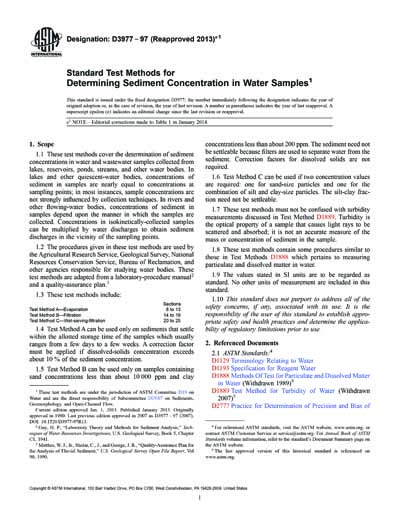Historical
ASTM D3977-97(2013)e1
Standard Test Methods for Determining Sediment Concentration in Water Samples
1.1 These test methods cover the determination of sediment concentrations in water and wastewater samples collected from lakes, reservoirs, ponds, streams, and other water bodies. In lakes and other quiescent-water bodies, concentrations of sediment in samples are nearly equal to concentrations at sampling points; in most instances, sample concentrations are not strongly influenced by collection techniques. In rivers and other flowing-water bodies, concentrations of sediment in samples depend upon the manner in which the samples are collected. Concentrations in isokinetically-collected samples can be multiplied by water discharges to obtain sediment discharges in the vicinity of the sampling points.
1.2 The procedures given in these test methods are used by the Agricultural Research Service, Geological Survey, National Resources Conservation Service, Bureau of Reclamation, and other agencies responsible for studying water bodies. These test methods are adapted from a laboratory-procedure manual2 and a quality-assurance plan.3
1.3 These test methods include:...
1.4 Test Method A can be used only on sediments that settle within the allotted storage time of the samples which usually ranges from a few days to a few weeks. A correction factor must be applied if dissolved-solids concentration exceeds about 10 % of the sediment concentration.
1.5 Test Method B can be used only on samples containing sand concentrations less than about 10 000 ppm and clay concentrations less than about 200 ppm. The sediment need not be settleable because filters are used to separate water from the sediment. Correction factors for dissolved solids are not required.
1.6 Test Method C can be used if two concentration values are required: one for sand-size particles and one for the combination of silt and clay-size particles. The silt-clay fraction need not be settleable.
1.7 These test methods must not be confused with turbidity measurements discussed in Test Method D1889. Turbidity is the optical property of a sample that causes light rays to be scattered and absorbed; it is not an accurate measure of the mass or concentration of sediment in the sample.
Content Provider
ASTM International [astm]






